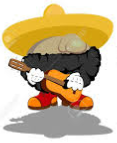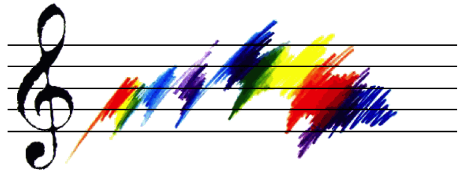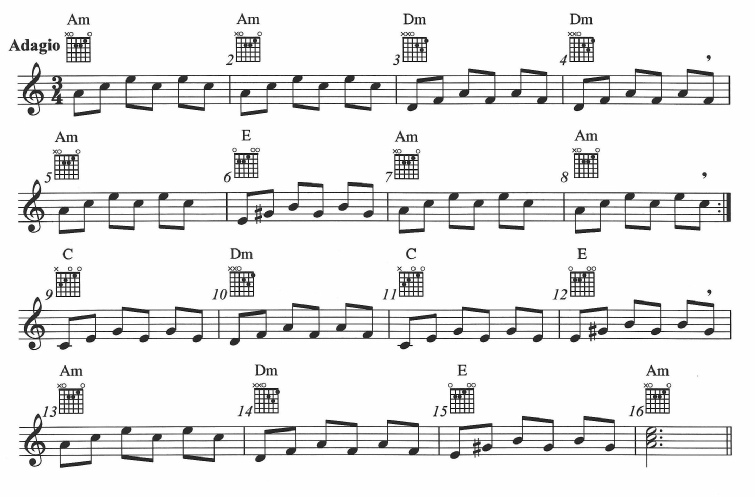
jm-








Improvising

Anyone can Improvise!
This is an introduction to musical improvisation for those who are completely new to it, but may also benefit those with some experience who would like to improve their skills. The advice and techniques given here are complemented by an improvising workshop and backing track which can be accessed on YouTube by clicking here.
Each main section in this introduction to improvising is listed below; clicking on a link will take you directly to that particular section.
* Improvising a melody in strict time
* Improvising techniques summary
* 2 accompaniments (backing tracks) for practise


‘Remember, improvising involves making spontaneous music from notes, scales or chords that you have already learned. It has nothing to do with taking yourself by surprise!..’




A
ctivity Time Exercise

Note: Make sure your scale is in the same key as any accompaniment or backing track you are going to use.
The backing track on YouTube is in the key of C major so, for the purpose of this exercise, we could use either the scale of C major or C major pentatonic. Both of these scales are shown below. You will perhaps notice that removing the fourth and seventh notes of the C major scale results in the scale of C major pentatonic. This applies to all major and major pentatonic scales.
B. Memorise the notes of your chosen scale
If you are not familiar with the notes of the key/scale, practise them until you know exactly where they are on your instrument (or until you can sing them at the correct pitch) without having to refer to music notation or a diagram. Your aim is to get to the point where you don't have to think about which are the correct notes. Good improvising begins with being completely familiar with all the notes you can use. Your style won't flow if you are even slightly hesitant.


‘Memorising the notes of the key/scale you are improvising with means you can give all your attention to rhythm and phrasing. If you have to think about where the correct notes are as well as the rhythm and phrasing AND listen to a beat or backing track it will quickly become confusing. Don't expect yourself to 'multi-

C. Play notes from your chosen scale at random using a variety of musical time values -

Note: when using a backing track listen to it a few times before you start improvising in order to familiarise yourself with the style and tempo.

Note: Backing tracks in various keys are available from a number of sources, including YouTube, Spotify and songbooks which come with supplementary CDs.
Chord progression in C major
Using an accompaniment or backing track
Below is a chord progression in the key of C major; the same one used (and repeated several times) for the backing track in the YouTube improvising workshop. You can use it to practice part 'C ' above, or as you work through the steps outlined below in Improvising a melody in strict time.
As an alternative to accessing this track online, you might get a fellow student to play the chord progression on a harmonic instrument (such as piano or guitar) while you improvise over it using notes from either the C major scale or C major pentatonic scale. Alternatively, you could record the progression yourself or put it together using a MIDI sequencer. (For information and guidance on using a sequencer see Composing a Dance Track Using a MIDI Sequencer on this website. Details on the key of C major and its chords can be found in the Reference Pages.)

Improvising a melody in strict time
As an aid to improvising in perfect time with your accompaniment or backing track, try the numbered steps below. An example of an electric guitar undertaking a similar step-

Note: This exercise applies specifically to music in 4/4 time, but of course most of the musical time values will work with other time signatures.
1. Whilst listening carefully to the beat of your backing track or accompaniment (if using either), play one semibreve (or whole note) in each bar, changing note at every new bar. Make sure you are keeping in strict time with the music and each note is clear and sustained for the full 4 beats. When you feel completely confident doing this, move on to step 2.
2. Still keeping the same steady 4 beats in a bar, now play two minims (or half notes) notes in each bar. This means you will be playing a note on beats 1 and 3 in every bar. As before, ensure you play in strict time and your notes are clear and sustained for their full 2 beat minim value. Only when you are happy that you can do this should you go to the next step.
3. Now try an improvisation using both semibreve and minim notes. Providing your notes are clear and sustained for their full values you will notice that already you are producing a legato melody that 'sings.' When ready, move to step 4.
4. The next time value to improvise in is crotchets (quarter notes), meaning you will now be playing a note on each beat of the bar. These can all be different notes from your chosen scale, but of course you can repeat some notes if you wish. Remember to make sure you play each note clearly and sustained for its full value; cutting notes short will stop them from 'singing', so try to avoid any unwanted (at least for now) staccato.
5. Now try using quavers (eighth notes), following the same procedure as in previous steps.
6. Now try combining crotchets (quarter notes) and quavers (eighth notes) in an improvisation.
7. And now it's time to combine semibreve, minim, crotchet and quaver note values in an improvisation. Take your time as you play and listen very carefully to ensure each note is clear, in strict time and played legato. Don't rush or allow yourself to become flustered. As you play a note, consider what the next one will be so that you reduce the risk of errors.



‘If at any point during an improvisation you start to feel under pressure, or that things are running out of control, try playing longer note values such as semibreves or minims; this will provide some 'breathing space' for you to collect your thoughts while you keep the improvisation going in the sustained long notes. Remember that a melody of long, sustained ('singing') notes played in time will sound far better than poorly played notes and hesitations.’
‘Always play in a tempo that you feel comfortable with, giving yourself time to think before you play each new note. If you are relaxed and confident as you play then you've got it right!’


‘A way to get a feel for musical phrasing is to listen to songs, paying attention to the following:
* Where does the singer pause or take a breath? These pauses or rests break up the melody into several phrases, giving it shape.
* How many different note values are there (minims, crotchets etc.)? These create rhythm.
* Can you hear OPEN and CLOSED phrases (or imperfect and perfect cadences)?’
Chord progression in F major





A
ctivity Time Exercise
Two accompaniments (backing tracks) for practise
Below are two additional chord progressions which you might record (repeating several times) -
The first chord progression is in 4/4 time and in the key of F major; its phrases are all two bars long (indicated by the phrase lines stretching above the bars). When you hear it you should recognise where there are opportunities to use OPEN and CLOSED phrases in your improvised melody. Remember, a CLOSED phrase ends on the key note so look for bars where chord I (the key chord) occurs.
The second progression is in 3/4 time and based on slow (adagio) arpeggios in the key of A minor.
Listen to both chord progressions a few times before attempting any improvising; this will make you familiar with each accompaniment and should give you some ideas as to the possible shape and style of your improvised melodies.
See the Reference Page for details of the scales and chords used in both of these keys.

Note: the little commas above bars 4, 8 and 12 are an alternative way of indicating the end of a musical phrase. Each phrase is therefore 4 bars long in this progression.


‘A good improvisation should be articulated with feeling, and flow naturally whatever its style. Remember, a few notes played with sincerity are better than a rapid assault of mechanically executed passages. Speed for its own sake is seldom moving or convincing. It can even become boring to the listener.’
‘For some inspiration and guidance you should of course listen carefully to different kinds of music that uses improvisation (jazz, blues, rock etc.) to hear how experienced musicians create phrases, express feeling and use musical elements such as key, tempo, dynamics, legato, staccato, syncopation, rubato and so on in their improvised solos.’
‘Only practising the techniques and trying out different musical ideas will develop your improvising skills in any style. The more you practise the easier and better it will become -
‘So keep practising. And enjoying!’

8. When you feel confident improvising with your scale and a variety of rhythm combinations, you can then try adding, one at a time, other note values including dotted crotchets (dotted quarter notes) with quavers (eighth notes), dotted minims (dotted half notes) and semiquavers (sixteenth notes).

Note: by using a variety of precise musical time values you automatically produce an interesting rhythm and a melody that is in perfect time with any accompaniment or backing track.
Once you are comfortable with basic improvising and your ability to play clear notes in perfect time, you should aim to develop a more natural style, thinking now about things like musical phrasing, the articulation of notes, and playing with feeling.

1. To 'CLOSE' a musical phrase (like a full stop in speech or a perfect cadence), end on the key note.
2. To keep a musical phrase 'OPEN' (like a comma in speech or an imperfect cadence), end a phrase on any note EXCEPT the key note.
This method can be used to create Question and Answer phrases, where the Question phrase ends OPEN and is immediately followed by the Answer phrase which ends CLOSED.
Practice creating musical phrases in your improvisations by adding rests and OPEN and CLOSED phrases.
*For more information see Cadences on this website.
Phrasing and melodic shape
Have you ever heard anyone comment about a musician being able to make their instrument 'talk?'
Well, good improvising, like speech (and singing), has shape, articulation and punctuation which is created by musical elements such as rests, cadences, staccato, legato and dynamics. Without these elements, the music would soon become dull to listen to.
Rests
Rests are very important in shaping musical phrases and making an improvisation more interesting. Without them, there would be no 'breathing spaces' or pauses to break up continuous passages of notes.
Every kind of musical note value of course has its equivalent rest, and you should experiment with a variety of rests both within musical phrases and at their conclusion (to create pauses between phrases).
Closed and Open phrases
Another very useful (and easy) way to add shape and punctuation to your improvisations is to have 'CLOSED' and 'OPEN' phrases. These are like *perfect and imperfect cadences in a melody, and can be formed as shown in this simple guideline:


“I would say the mark of a good musician is the ability to play one note and mean it, rather than play zillions of scales and not mean it.”
‘The above comment by Mike Oldfield perhaps best sums up what you should be aiming for when improvising (or indeed undertaking any kind of musical performance).
‘The expressive, unhurried improvisation style of another famous guitarist, Eric Clapton, has earned him worldwide acclaim (and the nickname 'slow hand'); proving that speed isn't everything, and that putting feeling into every note really gets results!
There are times, of course, when speed is exactly what is required; it creates excitement, drama, power, and these are all equally important elements in music. But you must learn to execute speed solos properly or they will just sound like an amateur trying, unsuccessfully, to impress. And to do that you must first be able to play slowly (and note perfect) anything you intend to play at speed, because if you can't play a musical passage perfectly at a slow speed you'll have no chance of playing it fast and accurate. So start with some slow, expressive music or else practise twice as hard to get those speed solos burning!
‘But in the meantime, here's a little extra tip: if you can't play faster note passages very well pick just one or two of the notes in a musical phrase and repeat them several times in faster note values, such as semiquavers (sixteenth notes). This is an 'instant fix' way to include some quicker rhythms in your improvised phrases since it is much easier to play the same note over and over than passages of different notes.’


Improvising Techniques Summary
* Use a variety of note values, long and short (e.g. semibreves, minims, crotchets, quavers, semiquavers, dotted notes). Longer notes values can be expressive so don't be reluctant to use them thinking that they will make your improvising sound too basic.
* Improvise in phrases. Improvised musical phrases can have patterns like speech and songs -
* Remember, CLOSED phrases end on a key note and OPEN phrases end on any other note of the key/scale.
* Using longer note values at the end of phrases helps to emphasise them, distinguishing one phrase from another.
* Use rests to give shape to a melody and create pauses between musical phrases
* As you play each note in an improvisation, consider what the next one will be. Rapid note changes can only happen when you know what is coming next -
* Try to incorporate the following into your improvisations to make them more interesting and give them character:
Accents
Ascending and descending note passages
Stepwise and leaping notes
Question and answer phrases
Legato
Staccato
Syncopation
Imitation
Dynamics
|
|




A
ctivity Time Exercise
Scat singing
Scat singing is a form of improvising with the voice, where meaningless words (like doo doo, bee doop, shoop shoo) are sung to random or improvised musical notes in the same key as the accompaniment.
If you are new to improvising you might find it helpful to try some scat singing first. That way, you can focus on the rhythm and phrasing without also having to concentrate on playing the correct notes on a musical instrument.
For examples of scat singing, have a look at the songwriting workshop, Analysing a Modern Song, on this website, and see the entry for scat singing in the Suggested Listening Lists (Unit 7 MELODY/HARMONY concepts). Examples of scat singing can also be located on YouTube.



Articulation
Playing perfect notes is important, but hearing them played in the same way and at the same dynamic level will eventually become dull to the listener. Altering the way notes are articulated -
Play it with feeling, man…
We can recognise it when we hear it in music -
So, just like an actor who has to get into character for a particular role, musicians need to focus on what their music is 'saying.' More than that, they need to really feel it! Even an improvisation that has no particular emotional message to convey will of course benefit from being played with the musician's complete comitment to and enjoyment of the style. When a performer really 'gets into' what he/she is playing it becomes infectious to the audience who will become absorbed in (or totally blown away by!) the performance.







Virtual Tablet



Click here

To let you hear, and give you some practise with, the techniques outlined below, an improvising workshop complete with examples and a backing track can be accessed on YouTube by clicking on the link above. Familiarise yourself with the following step-





Virtual Tablet



Click here

The chord progression above in the key of F major has
been recorded as a continuous backing track for you to practise improvising over. Click on the link above to access the track on YouTube.





Virtual Tablet








Virtual Tablet





To hear all of the above musical elements being put into practice, listen to the electric guitar improvisation at 5.52 in the YouTube workshop. Listen to it as many times as you need before attempting an improvisation for yourself with the backing track at 7.46.
Click here



Although experienced musicians make it sound completely spontaneous, good improvising is the product of years spent developing technique and learning notes and scale patterns that can be recalled in music that is made up on the spot. But that doesn't mean it is something only skilled musicians -

So, if you are a complete beginner, a bit unsure, or simply can't see how improvising is something you could do easily, then try the step-

Is improvising difficult?

A common mistake people make when they have a go at improvising is thinking it will just 'happen' if they pick up (or sit down at) their instrument and launch into it. Remarkably, rather than begin slowly with a handful of notes or a simple scale, they expect themselves to be able to improvise an interesting melody complete with a varied rhythm without having first thought about how to do it. They then become frustrated when they play lots of wrong notes and music that is out of time, now believing that improvising is far more difficult than they thought, or is a skill for which they have no ability. But that isn't true. What is true is that the would-

How to approach it wrongly

We know that improvising can be taken to a very high level of complexity by experienced musicians, but no special talent is required to start off. Anyone who can sing or play a musical scale can improvise. It's that simple.
To begin, you need only do two things:

1. Choose a scale/key in which to improvise and ensure you know its notes well enough to play or sing them from memory
2. Play or sing the notes of that scale/key at random using a variety of rhythms to a steady beat/pulse
OR
Play or sing the notes of that scale/key at random in a rubato style which doesn't keep to a strict beat but is musically expressive

How to approach it properly


Easy as A, B, C…
A. Choose a musical key/scale
Basic Improvising


The chord progression above in the key of A minor has
been recorded as a continuous backing track for you to practise improvising over. Click on the link above to access the track on YouTube.
Click here

Home | About | News | National 5 Music | Higher Music | Shop
Resources | Charity | Contact | Tuition | Links
Copyright © Joe McGowan 2016
National 5 Music
Improvising









Chord progression in F major





Chord progression in A minor





